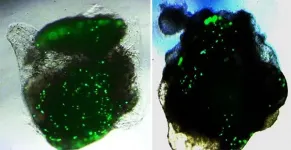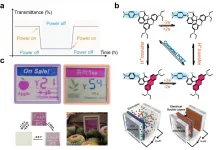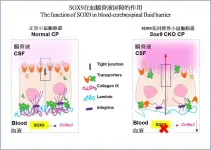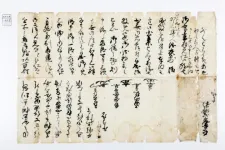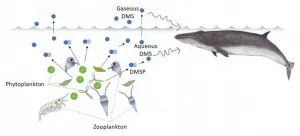Optimality in self-organized molecular sorting
2021-02-24
(Press-News.org) Torino, February 24, 2021 - The eukaryotic cell is the basic unit of animals and plants. At the microscope, it looks highly structured and subdivided in many membrane-bound compartments. Each compartment has a specific function, and its membrane is populated by specific molecules. How does the cell preserve this amazing internal order, and (in the absence of pathologies) does not degrade into a shapeless bunch of molecules? Such degradation is countered by a continuous process of molecule sorting by which similar molecules are collected and dispatched to the "right" destinations, similarly to what happens when a house is kept clean and tidy by daily chores. It's still mysterious, however, how a living cell may achieve this task without a supervisor directing it.
In a recent Physical Review Letters paper, a collaboration of researchers from Politecnico di Torino, Università di Torino, Italian Institute for Genomic Medicine - IIGM, Istituto Nazionale di Fisica Nucleare - INFN, and Landau Institute for Theoretical Physics (Moscow), hypothesizes that this process of molecular sorting emerges from the combination of two spontaneous mechanisms. The first mechanism is the propensity of similar molecules to aggregate on membranes in the form of "patches", or "droplets", in the same way as water droplets form in a vapor cloud that is cooled down. The second mechanism is the tendency of such droplets to bend the membrane, leading to the formation and further detachment of small vesicles enriched in the molecular components of the original droplets. The various membrane compartments of the eukaryotic cell act thus similarly to the vessels and tubes of a natural distiller, or alembic, that continuously sorts and redirects molecular components toward the appropriate destinations.
In the published work, this process of molecular sorting is studied with mathematical tools and computer simulations, showing that the propensity to aggregation is the main control parameter of the process. For each group of molecules there exists an optimal value of this parameter (neither too large, nor too small), such that the sorting process takes place with the maximum possible speed. Actually, some propensity to molecular aggregation is needed to drive the process, but when the propensity to aggregation is too large, the molecules "freeze" in a large number of small "droplets" that grow very slowly, and the overall sorting process slows down. Experimental observations of this distillation process in cells isolated from the blood vessels of human umbilical cords confirm this theoretical picture, and suggest that evolution may have led the cells to work in the optimal parameter region, where the sorting process achieves maximum efficiency.
These findings are of particular interest, since the misregulation of molecular sorting is a hallmark of severe pathologies, such as cancer. The theoretical identification of the parameters that control the process is an important first step toward a better understanding of the origin of such disruptions and the development of therapies.
INFORMATION:
The research was supported also by: Fondazione Collegio Carlo Alberto - Torino, Russian Academy of Sciences, National Research University Higher School of Economics (HSE).
ELSE PRESS RELEASES FROM THIS DATE:
2021-02-24
COVID-19, the disease caused by the pandemic coronavirus SARS-CoV-2, is primarily regarded as a respiratory infection. Yet the virus has also become known for affecting other parts of the body in ways not as well understood, sometimes with longer-term consequences, such as heart arrhythmia, fatigue and "brain fog."
Researchers at University of California San Diego School of Medicine are using stem cell-derived organoids -- small balls of human cells that look and act like mini-organs in a laboratory dish -- to study how the virus interacts with various organ systems and to develop therapies to block infection.
"We're finding that SARS-CoV-2 doesn't infect the entire body in the same way," said Tariq Rana, PhD, professor ...
2021-02-24
If Affordable Care Act protections for pre-existing condition coverage are no longer available, the coronavirus pandemic would leave many Americans - a disproportionate number of whom are people of color - without health insurance, a new Oregon Health & Science University study indicates.
Published in the Journal of the American Board of Family Medicine, the study's findings reveal a third of the more than 7,500 COVID-19 patients who received care at U.S. community health centers between March and October 2020 did not have a pre-existing condition prior to contracting the novel ...
2021-02-24
UCLA RESEARCH BRIEF
Enrique Rivero
FINDINGS
Older people correctly ascertained basic information such as dosage and duration of use for more than 70% of the medications they were prescribed, regardless of whether their physician explained it during an office visit. But when physicians failed to verbally provide information about potential side effects, people incorrectly assumed that about 55% of their prescribed medications had none. Even when physicians did discuss possible side effects, their patients incorrectly assumed there were no side effects for 22% of the medications.
BACKGROUND
There is a shortage of data about how well people understand basic information about the medications they are prescribed. This information ...
2021-02-24
The development of low-energy-consumption and user-friendly electronic displays has become a long-term goal for future global sustainable development. Bistable electronic display, which requires very little electric drive to turn pages without consuming additional power to continuously display information/images, is one of the very good potential alternatives. Reflective display technologies with partial/complete bistable characteristics include e-ink, cholesteric liquid crystal, and electrochromic technologies, etc. They display information in light reflection mode, which can still be read under high-brightness outdoor sunlight and relatively dark indoor environments. It is also very friendly to the ...
2021-02-24
The yellow fever mosquito (Aedes aegypti) is a main vector of deadly diseases like dengue fever, chikungunya, and the Zika virus, which result in hundreds of thousands of deaths worldwide each year. Because Ae. aegypti prefers to bite humans and there are no vaccines for many of these diseases they carry, developing methods to control these insects is imperative in the fight to control illness.
In a study recently published in Proceedings of the National Academy of Sciences, a Yale-led research team developed a new method to track how Ae. aegypti move through the environment. ...
2021-02-24
Live tracking and analyzing of the dynamics of chimeric antigen receptor (CAR) T-cells targeting cancer cells can open new avenues for the development of cancer immunotherapy. However, imaging via conventional microscopy approaches can result in cellular damage, and assessments of cell-to-cell interactions are extremely difficult and labor-intensive. When researchers applied deep learning and 3D holographic microscopy to the task, however, they not only avoided these difficultues but found that AI was better at it than humans were.
Artificial intelligence (AI) is helping researchers decipher images from a new holographic microscopy technique needed to investigate ...
2021-02-24
The finding, recently published in the prestigious scientific journal Proceedings of the National Academy of Sciences of the United States of America (PNAS), has provided the scientific community a novel understanding to the molecular regulatory mechanisms behind the function of the blood-CSF barrier and lays the groundwork for developing novel therapeutic strategies for preventing and treating neurodevelopmental disorders.
Dysfunction of blood-cerebrospinal fluid barrier is common in various neurological diseases
CSF is a clear, colourless body fluid that surrounds the brain and spinal cord, providing them a cushion against injuries. It also ...
2021-02-24
In Japan, the suppression of Christianity increased from the end of the 16th century to the beginning of the 17th century, and many missionaries and Japanese believers were martyred during this period. New research has uncovered a letter indicating that Hosokawa Tadaoki, lord of the Kokura domain from 1600 to 1620, ordered the execution of Diego Hayato Kagayama, a chief vassal of the Hosokawa family, and the banishment of Genya Ogasawara, both Christians. The punishment and martyrdom of both men was previously known only from reports by Jesuit missionaries to Rome. The discovery of primary historical documents created within the Hosokawa ...
2021-02-24
Integrated photonics was rejuvenated as Si starting challenging the dominant position of conventional III-V compound semiconductors at onset of the new millennium. Heterogeneous Si photonics utilizes wafer bonding to transfer functioning non-Si thin film onto Si substrate to make up missing or weak optoelectronic functionalities of Si material. In the past 15 years, it has evolved into a broad technology with many branches as shown in Fig. 1. As the most mature one among them, heterogeneous III-V-on-silicon integration provides an ideal platform to marry their respective material and production advantages. Two veteran researchers in this field, Dr. Di Liang from Hewlett Packard Labs and Prof. ...
2021-02-24
A joint research project between organizations in Japan and the US has demonstrated that zooplankton, a major food source for marine predators, can be located by following the concentration gradient of the chemical dimethyl sulfide (DMS) in ocean water and air. Currently, little is known about how marine predators search for and find enough food to maintain their body size. This study is expected to expand research into the chemical triggers of marine organisms while foraging.
Zooplankton, such as krill and copepods are the main energy source for many large marine animals. The big predators must consume a large amount of these tiny creatures to provide ...
LAST 30 PRESS RELEASES:
[Press-News.org] Optimality in self-organized molecular sorting
